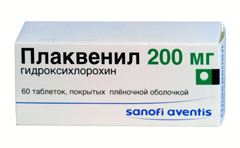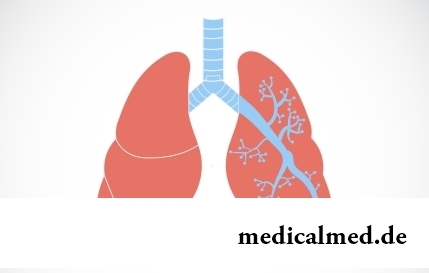





Plaquenil
Application instruction:
 Plaquenil – the drug having antimalarial properties and having immunodepressive and antiinflammatory effect.
Plaquenil – the drug having antimalarial properties and having immunodepressive and antiinflammatory effect.
Form of release and structure
Dosage form of Plaquenil – a tablet, film coated: biconvex, round, white color, on one of the parties an engraving - "HCQ", on other party – "200" (on 10 pieces in blisters, on 6 blisters in cardboard packs).
Contains in 1 tablet:
- Active ingredient: hydroxychloroquine sulfate – 200 mg;
- Auxiliary components: magnesium stearate, K25 povidone, lactoses monohydrate, starch corn, опадрай OY-L-28900 (macrogoal 4000, gipromelloza, titanium dioxide (E171), lactoses monohydrate).
Indications to use
Plaquenil is applied to treatment of a pseudorheumatism, a juvenile pseudorheumatism, a system lupus erythematosus, a diskoidny lupus erythematosus.
At malaria (except for caused chloroquine - resistant strains of Plasmodium falciparum) drug is used for the purpose of prevention and for therapy of bad attacks of the malaria caused by Plasmodium ovale, Plasmodium vivax and Plasmodium malariae and sensitive strains of Plasmodium falciparum, and also at radical treatment of the malaria caused by Plasmodium falciparum strains, sensitive to hydroxychloroquine.
Contraindications
Absolute:
- Retinopathy;
- Hereditary insufficiency of lactase, lactose intolerance, galactosemia or sprue of a glucose/galactose (as a part of drug there is a lactose);
- The pregnancy period (an exception – cases when the potential advantage of therapy for mother is significantly higher than risk of development of pathologies of a fruit);
- Children's age up to 6 years (it is not applied at children with ideal body weight less than 31 kg) (in case of need performing long therapy at children is more senior than 6 years the probability of toxic effects is increased);
- Hypersensitivity to components of drug and other derivatives 4 aminoquinolines.
Relative (Plaquenil should be applied with care because of the increased probability of side effects):
- Visual frustration: disturbance of color sight, decrease in visual acuity, narrowing of fields of vision, and also a concomitant use of the drugs promoting emergence of adverse ophthalmologic reactions (in connection with danger of progressing of visual frustration and retinopathies);
- Hematologic diseases (including data in the anamnesis);
- Serious neurologic illness, psychoses (including data in the anamnesis);
- Late skin porphyria (risk of an aggravation), psoriasis (risk of aggravation of skin manifestations), concomitant use of the drugs promoting emergence of skin reactions;
- Renal and/or liver failure, hepatitis, concomitant use of the drugs capable to exert adverse impact on function of kidneys and/or a liver (in case of heavy abnormal liver functions or kidneys the dose is required to be selected, exercising control of concentration in hydroxychloroquine plasma);
- Deficit glyukozo-6-fosfatdegidrogenazy;
- Serious illness of the digestive tract (DT);
- Hypersensitivity to quinine (cross allergic reactions are possible).
When breastfeeding (lactation) it is required to estimate carefully need of use of Plaquenil as in small amounts hydroxychloroquine is emitted with breast milk, and children about one year have considerably a hypersensitivity to toxic effects of 4 aminoquinolines.
Route of administration and dosage
The tablets Plaquenil are intended for oral administration, accept them along with food or between meals, washing down with 1 glass of milk.
It is important to consider cumulative activity of hydroxychloroquine: its therapeutic action begins to be shown several weeks later from the beginning of regular administration of drug, at the same time side effects can arise relatively early. The required therapeutic effect develops several months later. In the absence of objective improvement of a condition of the patient within half a year of treatment by hydroxychloroquine, use of Plaquenil should be stopped.
Therapy of the pseudorheumatism (P):
- Adults, including elderly patients: the minimal effective dose to 6,5 mg/kg of body weight a day (calculation is made on ideal body weight, but not on real) can make 200 mg (1 tablet) or 400 mg (2 tablets) a day; at an initial dose of 400 mg it is divided into several receptions; on reaching obvious improvement the dose can be lowered to 200 mg, in case of efficiency reduction it is possible to increase a maintenance dose to 400 mg;
- Children: a minimal effective dose – to 6,5 mg/kg of body weight a day (calculation is made on ideal weight) therefore tablets of 200 mg are not intended for children with ideal body weight up to 31 kg.
The combined use of Plaquenil with glucocorticosteroids (GKS), a methotrexate, salicylates, non-steroidal anti-inflammatory drugs (NPVS), other therapeutic substances / drugs of the second row safely. Several weeks later from the beginning of reception of medicine of a dose of salicylates and GKS can be reduced, or the termination of reception of these drugs is possible. At the same time doses of GKS need to be reduced gradually, reducing the accepted amount of substances once in 4-5 days: a cortisone – ≤ 5-15 mg, a hydrocortisone – ≤ 5-10 mg, Prednisolonum and Prednisonum – ≤ 1-2,5 mg, Methylprednisolonum and Triamcinolonum – ≤ 1-2 mg, dexamethasone – ≤ 0,25-0,5 mg.
For therapy of the system lupus erythematosus (SLE) the average initial dose of 400 mg (2 tablets) 1-2 times a day, a course of treatment – from several weeks to several months, depending on reaction of the patient is recommended to adult patients; a long maintenance therapy – 200-400 mg a day.
Prevention of bad attacks of malaria, owing to infection of Plasmodium malariae and sensitive strains of Plasmodium falciparum, once a week, in the same day:
- Adults – on 400 mg;
- Children – on 6,5 mg/kg of ideal body weight of the child, but (irrespective of weight) no more dose for adults.
Preventive therapy is recommended to be begun in 2 weeks prior to entrance to an endemic zone if it is impossible, the double (load) dose is appointed: for adults – 800 mg, for children – 12,9 mg/kg of ideal body weight (but ≤ 800 mg), divided into two receptions at an interval of 6 hours. It is necessary to continue administration of drug for prevention of a disease for 8 weeks after escape of an endemic zone.
At bad attacks of malaria at adults: 800 mg (4 tablets) once, then 400 mg (2 tablets) later 6-8 h, further – on 400 mg 2 more days (totally 2000 mg of hydroxychloroquine of sulfate).
Also efficiency, as an alternative way, a single dose of Plaquenil in a dose of 800 mg was proved.
The dose for children – 3,2 mg/kg of ideal weight (but ≤ 2000 mg), is expected 3 days of reception according to the following scheme:
- The I dose (at the beginning of an attack) – 12,9 mg/kg, but ≤ 800 mg;
- The II dose (after the I dose in 6 hours) – 6,5 mg/kg, but ≤ 400 mg;
- The III dose (after the II dose in 18 hours) – 6,5 mg/kg, but ≤ 400 mg;
- The IV dose (after the III dose in 24 hours) – 6,5 mg/kg, but ≤ 400 mg.
Radical treatment of the malaria caused by Plasmodium vivax and Plasmodium malariae: it is required to accept derivative 4 aminoquinolines along with derivatives of a 8-aminokhinolon.
The given doses of Plaquenil are expected hydroxychloroquine sulfate and are not equivalent to basis doses.
For adults the dose can be calculated taking into account ideal body weight as well as for children.
Side effects
- Blood and lymphatic system: frequency is unknown – aplastic anemia, anemia, oppression of a marrowy hemopoiesis, an agranulocytosis, thrombocytopenia, a leukopenia;
- Immune system: frequency is unknown – a Quincke's disease, a small tortoiseshell, a bronchospasm;
- Metabolism and food: often – anorexia; frequency is unknown – probability of an aggravation of a porphyria, a hypoglycemia;
- Disturbances of mentality: often – affective lability; infrequently – nervousness; frequency is unknown – suicide behavior, psychoses;
- Central and peripheral nervous system: often – a headache; infrequently – dizziness; frequency is unknown – spasms;
- Organ of sight: often – the sight illegibility connected with accommodation disturbances (dozozavisimy and reversible); infrequently – a retinopathy with defects of fields of vision and changes in pigmentation (reversible in an early form after the treatment termination by hydroxychloroquine; preservation of not diagnosed retinopathy increases risk of an irreversible damage of a retina of an eye even after drug withdrawal; in the beginning changes of a retina can be asymptomatic, be shown by scotomas of pericentral or paracentral types, passing scotomas, and also disturbances of color sight), changes of a cornea, including swelled also opacification (can be asymptomatic or cause emergence of changes, reversible after the termination of a course of therapy, such as a sight illegibility, photophobia, auras); frequency is unknown – a macular degeneration and a maculopathia (can be irreversible);
- Acoustic organ and labyrinth disturbances: infrequently – a sonitus, вертиго; frequency is unknown – deafness;
- Cardiovascular system: frequency is unknown – a cardiomyopathy owing to which heart failure up to a fatal outcome can develop (chronic cardial toxicity should be taken into account in case of detection of disturbances of conductivity (blockade of legs of a ventriculonector and/or disturbances of atrioventricular conductivity) or at a hypertrophy of both ventricles (involution of such changes is possible with drug withdrawal));
- GIT (symptoms usually at once pass after reduction of a dose or drug withdrawal): very often – nausea, an abdominal pain; often – vomiting, diarrhea;
- Gepatobiliarny system: infrequently – aberrations of laboratory indicators of functional hepatic trials; frequency is unknown – a fulminantny liver failure;
- Skin and hypodermic fabrics: often – an itch, skin rash; infrequently – disturbances of pigmentation of mucous membranes and skin, an alopecia, decolouration of hair (after the therapy termination usually these changes quickly take place); frequency is unknown – violent rash (including a multiformny erythema, Stephens-Johnson's syndrome, exfoliative dermatitis, photosensitivity, a toxic epidermal necrolysis), DRESS syndrome (the medicinal skin reaction which is followed by system manifestations and an eosinophilia), OGEP (acute generalized exanthematous пустулез; can be followed by a hyperleukocytosis and temperature increase; it is necessary to distinguish from psoriasis; after the treatment termination an outcome usually favorable);
- Skeletal and muscular and connecting fabrics: infrequently – sensomotor disturbances; frequency is unknown – the neuromyopathy or a myopathy of skeletal muscles leading to the progressing weakness with an atrophy of proximal muscular groups (can be reversible after the termination of administration of drug, but several months can be necessary for full rehabilitation), decrease in nerve conduction, suppression of tendon jerks.
Classification of frequency of undesirable side effects:> 1/10 – very often; ≥ 1/100-<1/10 – it is frequent; ≥ 1/1000-<1/100 – infrequently; ≥ 1/10 000-<1/1000 – it is rare; <1/10 000 – in isolated cases; it is not possible to determine frequency by the available data – frequency is unknown.
Symptoms of overdose of hydroxychloroquine are: vision disorders, a headache, a collapse, a hypopotassemia, spasms, disturbances of conductivity and a rhythm which involve an apnoea and hearts. As such reactions can directly develop after acceptance of an overdose of Plaquenil, it is necessary to carry out emergency treatment – to take measures for removal of drug from a stomach (to cause artificially vomiting, to carry out washing), to accept absorbent carbon in a dose, at least by 5 times exceeding the accepted hydroxychloroquine dose. Reasonablly parenteral administration of diazepam, is data on decrease on its background of cardiotoxicity of chloroquine.
For further treatment in case of need carry out antishock therapy and the artificial ventilation of the lungs (AVL). The patient has to be under constant medical control not less than 6 hours after stopping of symptoms of overdose.
The overdose of 4 aminoquinolines at children is especially dangerous, even in case of use of drug in a dose of 1000-2000 mg the lethal outcome is possible.
Special instructions
Toxic impact of hydroxychloroquine on a retina of an eye is considerably dozozavisimy. At use of means in doses to 6,5 mg on kg of ideal body weight the frequency of developing of a retinopathy small. In case of exceeding of the recommended daily doses the risk of development of a retinopathy sharply increases, and its emergence accelerates.
Prior to long therapy it is required to undergo the careful inspection of eyes including survey of an eyeground, visual acuity definition, assessment of fields and color sight. Further in the course of treatment such inspection is recommended to be undergone at least 1 time in half a year.
The following states / situations are the reason for more frequent inspection of patients:
- The daily dose of hydroxychloroquine exceeds 6,5 mg on kg of ideal body weight (at patients with an excess weight the overdose is possible);
- Renal failure;
- The total accepted dose for the expired period more than 200 000 mg;
- Advanced age;
- Reduced visual acuity.
Any visual frustration (change of color sight, decrease in visual acuity) are an indicator for immediate drug withdrawal and ensuring careful observation of a condition of sight of the patient as such changes of a retina are capable to progress even after cancellation of means.
In case of a long course of therapy it is periodically necessary to do full laboratory blood test; hydroxychloroquine is cancelled at emergence of hematologic disturbances.
As children are especially sensitive to toxic effects of 4 aminoquinolines, especially carefully it is required to meet storage conditions and to remove Plaquenil from places, available to children.
The patients receiving drug long time periodically have to undergo inspection of functions of skeletal muscles and expressiveness of a tendon jerk at the neurologist. At observation of muscular weakness drug stops being accepted.
In the relation chloroquine - resistant strains of Plasmodium falciparum, and also the vneeritrotsitny Plaquenil forms Plasmodium malariae, Plasmodium ovale, Plasmodium vivax is not effective therefore it cannot prevent infection with these microorganisms when using as means for prevention of bad attacks of malaria as means for prevention of a recurrence of the diseases caused by these activators.
It is necessary to be careful, managing vehicles and difficult mechanisms as hydroxychloroquine can break accommodation owing to what the clearness of visual perception worsens. If this state does not pass in itself over time, the dose of drug should be reduced temporarily.
Medicinal interaction
- Digoxin – increase in its concentration in serum is possible (it is recommended to reduce a digoxin dose under control of plasma concentration);
- Hypoglycemic drugs, insulin – decrease in their dose in connection with possible strengthening of effects at the beginning of therapy by hydroxychloroquine can be required;
- Antacids – can reduce hydroxychloroquine absorption therefore it is necessary to observe an interval not less than 4 hours between receptions.
Terms and storage conditions
To store in the place unavailable to children, at a temperature not above 25 °C.
Period of validity – 3 years.
Name of drug
Price
Drugstore
Plaquenil тбл п / about 200 mg No. 60, Sanofi/Aventis
1212 rub.
 Network of the Moscow drugstores of IFC
Network of the Moscow drugstores of IFCDuring life the average person develops neither more nor less two big pools of saliva.

Cold – a state known to everyone which is followed by cold, cough, high temperature, a pharyngalgia. Often перво...
Section: Articles about health
The immunity role in growth of the child is invaluable. The proteins-immunoglobulins produced by immune system preserve the child against the diseases capable − owing to an organism weak still − to serve as a stressful factor, to become the reason of many complications and delays in unless...
Section: Articles about health
High temperature - a frequent symptom of such widespread diseases as a SARS, quinsy, pneumonia, etc. To reduce heat, having facilitated a condition of the patient, doctors recommend to accept antipyretics, however their use is not always possible. Too frequent use of these drugs can lead to allergic reactions, and also overdose, causing poisoning. It happens also that there are no antipyretics simply in the house. In these situations it is pertinent to use it...
Section: Articles about health
Food with the increased content of sugar is attractive to most of people - it is scientifically confirmed fact. Business here not in a nevozder...
Section: Articles about health
"Epilepsy" doctors made the diagnosis in antique times. Displays of an illness and pattern of its development are very well studied. However for nonspecialists this disease remains to not less mysterious, than in the ancient time. Many delusions are connected with epilepsy...
Section: Articles about health
Diseases of joints often begin imperceptibly for the person. The first stages of destruction of the cartilaginous tissue providing soft and free sliding of heads of bones in joint bags proceed slowly and absolutely without serious consequences. Especially unpleasantly for the fact that this process is not connected with advanced age: degradation of joint surfaces is, as a rule, noticeable after 30 years. It means that practically each able-bodied person at any time can face sad results...
Section: Articles about health
Some people consider what for medicine of the 21st century of secrets in the field of health of the person almost does not exist. It absolutely not so. Than Bol...
Section: Articles about health
Since the moment when the child becomes a school student, his sight begins to be exposed to the strengthened loadings which are supplemented with viewing of animated films and long computer games. During this period of life of the child development not completely created bodies to a zra...
Section: Articles about health
Venereal diseases in medicine are called the infections which are transmitted preferential sexually, now they and are called - infections, sexually transmitted, or STD. Among them is also life-threatening. In spite of the fact that the majority of diseases such will respond to treatment, they are widespread everywhere, and there is no tendency to decrease in incidence. Besides, some of them promptly look younger: statistically, a third of young people at the age of 16-22 years of a str...
Section: Articles about health
It seems, quite recently you brought the baby from maternity hospital, but time flew by, and here it is already going to join the first...
Section: Articles about health
Hemorrhoids – extremely widespread disease. Periodically arising inflammations and bleeding of hemorrhoidal nodes cause serious discomfort to nearly fifteen percent of adults. Meanwhile, having a clear idea of the aggravation reasons...
Section: Articles about health
Radiological methods of a research are applied in medicine more than hundred years, and thanks to them millions of lives were saved. In many cases without X-ray it is impossible to make exact idea of a condition of bodies and fabrics, it is correct to make the diagnosis. Nevertheless, many myths about researches such continue to exist. Let's consider the most widespread of them....
Section: Articles about health
Residents of big cities quite often have a disease which is known as the syndrome of chronic fatigue (SCF) today. This illness...
Section: Articles about health
Sugar - the digestible refined product which is not of special value for an organism of the modern person. The use of sugar in food is based rather on the psychological dependence caused by desire to indulge itself with something tasty, and in дальнейш...
Section: Articles about health
One of the major chemical processes happening in a human body are oxidation reactions. They go with participation of fats and carbohydrates which we receive from food, and the oxygen getting to us from air. A main goal of such reactions is obtaining the energy necessary for life activity. Unfortunately, as a result of these processes dangerous by-products – so-called free radicals are allocated. To minimize harm which they can cause to the person neo...
Section: Articles about health
The climax, or menopause is the normal process of the termination of genital function of the woman which is followed serious hormonal...
Section: Articles about health
All diseases from nerves – in this joke a big element of truth, are said by doctors. Constant stresses lead to decrease in protective forces of an organism, and it becomes vulnerable for a set of diseases. It is wrong to think that the stress is a problem of the present. Life of people and hundred...
Section: Articles about health
In consciousness of our many compatriots idea that folk remedies if are no more effective, than medicinal "chemistry" strongly took roots, then are precisely less harmful. Unfortunately, it is not always fair: some methods of treatment consecrated with "century national experience" can work so on the patient that it will need urgent intervention of physicians....
Section: Articles about health
Popular joke that there are no healthy people, and is nedoobsledovanny, most of us considers an honest truth, and put that...
Section: Articles about health
The healthy nutrition is the invariable principle of health and good health for long years of the woman. Nevertheless, in a diet at each stage of life there are the features allowing to support an organism by those substances which are most necessary...
Section: Articles about health
Frosty air, fresh wind and easy snowball at most of Russians are associated with cheerfulness, health and cheerful entertainments on which our winter is so generous. But, unfortunately, cold season sometimes brings also troubles with health. It is not about seasonal colds and frostbites, and about those chronic illnesses which symptoms are shown preferential in the winter....
Section: Articles about health
For the last decades the diabetes mellitus of the second type became really world problem. Number of cases annually cart...
Section: Articles about health
The technique of acupuncture (acupuncture) is used in the medical purposes more than three and a half millennia. It is eurysynusic and recognized as official medicine in the majority of the developed countries of the world. Influence by fine needles on so-called points...
Section: Articles about health
Small appetite at the child – the complaint which pediatricians should hear practically from each mother. Most often it is carried to the category of children's whims, however the refusal of food in certain cases can be to alarming symptoms therefore it cannot be ignored....
Section: Articles about health
They say that to ensure health and longevity of people it is obliged. Really, at competent approach to these questions, we will pass...
Section: Articles about health
With age in a human body harmful substances collect. We receive them with food and water, at inhalation of the contaminated air, reception of medicines, use of household chemicals and cosmetics. A considerable part of toxins accumulates in a liver, osnovno...
Section: Articles about health
When overcomes feeling of hunger, and an opportunity to have dinner fully is absent, having a snack − the meals, small on volume, stabilizing sugar level in blood comes to the rescue. The relation of nutritionists to having a snack more often negative, but only because as snack people choose the most caloric products with the increased amount of "bystry" carbohydrates: cookies, rolls, chips, candies. Nevertheless, the advantage of having a snack is obvious to weight loss: the person avoids strong feeling of hunger...
Section: Articles about health

